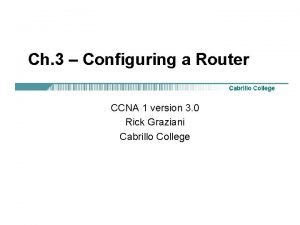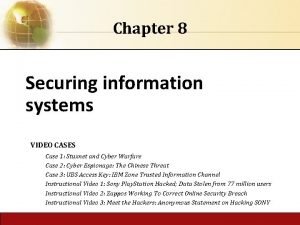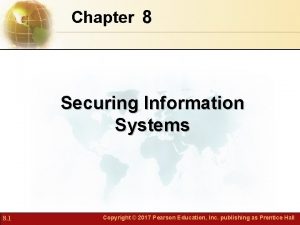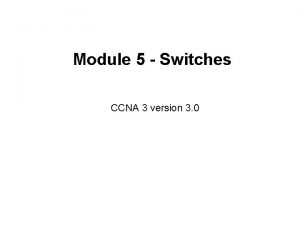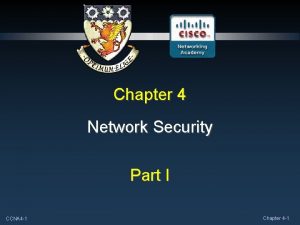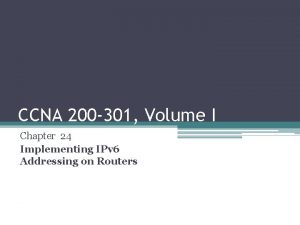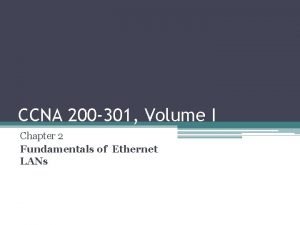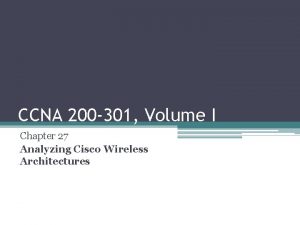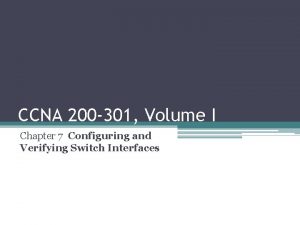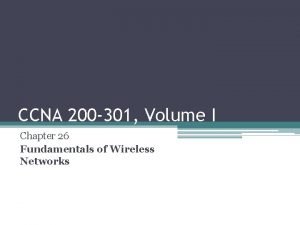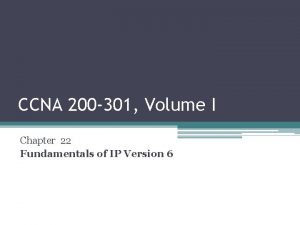CCNA 200 301 Volume I Chapter 28 Securing















- Slides: 15

CCNA 200 -301, Volume I Chapter 28 Securing Wireless Networks

Objectives • • Anatomy of a Secure Connection Wireless Client Authentication Methods Wireless Privacy and Integrity Methods WPA, WPA 2, and WPA 3

Wireless Transmissions Reaching Unintended Recipients

Authenticating a Wireless Client

Authenticating a Wireless AP

Encrypting Wireless Data to Protect Data Privacy

Checking Message Integrity over a Wireless Network

Open Authentication • Open authentication is true to its name; it offers open access to a WLAN. • The only requirement is that a client must use an 802. 11 authentication request before it attempts to associate with an AP. No other credentials are needed.

WEP • WEP uses the RC 4 cipher algorithm to make every wireless data frame private and hidden from eavesdroppers. • The algorithm uses a string of bits as a key, commonly called a WEP key, to derive other encryption keys—one per wireless frame. • WEP is known as a shared-key security method.

802. 1 x Client Authentication Roles

EAP-FAST The PAC is a form of shared secret that is generated by the AS and used for mutual authentication. EAP-FAST is a sequence of three phases: • Phase 0: The PAC is generated or provisioned and installed on the client. • Phase 1: After the supplicant and AS have authenticated each other, they negotiate a Transport Layer Security (TLS) tunnel. • Phase 2: The end user can then be authenticated through the TLS tunnel for additional security.

TKIP adds the following security features using legacy hardware and the underlying WEP encryption: • MIC: This efficient algorithm adds a hash value to each frame as a message integrity check to prevent tampering; commonly called “Michael” as an informal reference to MIC. • Time stamp: A time stamp is added into the MIC to prevent replay attacks that attempt to reuse or replay frames that have already been sent. • Sender’s MAC address: The MIC also includes the sender’s MAC address as evidence of the frame source. • TKIP sequence counter: This feature provides a record of frames sent by a unique MAC address, to prevent frames from being replayed as an attack. • Key mixing algorithm: This algorithm computes a unique 128 -bit WEP key for each frame. • Longer initialization vector (IV): The IV size is doubled from 24 to 48 bits, making it virtually impossible to exhaust all WEP keys by bruteforce calculation.

CCMP The Counter/CBC-MAC Protocol (CCMP) is considered to be more secure than TKIP. CCMP consists of two algorithms: • AES counter mode encryption • Cipher Block Chaining Message Authentication Code (CBC-MAC) used as a message integrity check (MIC)

GCMP The Galois/Counter Mode Protocol (GCMP) is a robust authenticated encryption suite that is more secure and more efficient than CCMP. GCMP consists of two algorithms: • AES counter mode encryption • Galois Message Authentication Code (GMAC) used as a message integrity check (MIC GCMP is used in WPA 3, which is described in the following section.

Comparing WPA, WPA 2, and WPA 3
 Ccna 200-301 slides
Ccna 200-301 slides Ccna 200-301 ppt slides download
Ccna 200-301 ppt slides download 100+200+200
100+200+200 Securing information systems
Securing information systems Chapter 8 securing information systems
Chapter 8 securing information systems Securing information systems
Securing information systems Chapter 8 securing the republic summary
Chapter 8 securing the republic summary Chapter 8 securing information systems
Chapter 8 securing information systems Chapter 8 securing information systems
Chapter 8 securing information systems Ccna 3 chapter 1
Ccna 3 chapter 1 Ccna 7 layers
Ccna 7 layers Ccna 4 chapter 4
Ccna 4 chapter 4 Modern network security
Modern network security Ccna 4 chapter 1
Ccna 4 chapter 1 Ccna chapter 7
Ccna chapter 7 Ccna 2 chapter 3
Ccna 2 chapter 3

